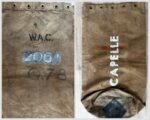Bocholt 1945 | Then and now
This post is also available in:
 Nederlands
Nederlands

Just before Operation Plunder, Bocholt was heavily bombed by the Allies, resulting in the destruction of 85% of the city. Following this bombardment, the attack was launched by the British 53rd (Welsh) Infantry Division, which had to navigate through the ruins.
Operation Plunder and Varsity
Before the Allied advance, the Rhine formed the last natural barrier towards Berlin. The crossing of the Rhine between Rees and Wesel was codenamed Operation Plunder and began in the late afternoon on March 23, 1945. An impressive force of a million soldiers from three different countries participated in this operation. On the western bank of the Rhine, the Allies had gathered more than 4,000 pieces of artillery, while over 250,000 tons of supplies were brought to the front. The preparations for the crossing were carefully concealed from the Germans by a massive smoke screen.
In support of the crossing, Operation Varsity was launched, the largest airborne operation ever conducted in a single day. A staggering 14,000 paratroopers were dropped east of the Rhine behind enemy lines. Their task was to establish and expand a bridgehead, enabling the Germans to be attacked from two sides and the artillery targeting the Rhine to be neutralized. Operation Plunder was highly successful. The German resistance was completely broken by the intense artillery barrage, and in the first two hours of the operation, the Allies lost only 31 men. Winston Churchill was present at Field Marshal Montgomery’s headquarters to witness the beginning of this final chapter in the war against Germany.
The Battle of Bocholt
Just before Operation Plunder, Bocholt was heavily bombarded by the Allies, resulting in the destruction of 85% of the city. The damage was estimated at 2,133,000 Reichsmarks, primarily caused by devastating forest fires resulting from incendiary bombs that fell in areas such as Diepenbrockstraße, Stenernerstraße, Rebenstraße, Ravardistraße, Nobelstraße, Schanze, and Gartenstraße. During the bombings and artillery shelling between March 22 and 24, 1945, 341 people lost their lives.
On March 29, 1945, the attack on Bocholt was initiated by the 53rd (Welsh) Infantry Division. During the attack, soldiers of the Welsh division were fired upon from all directions by the German troops, who were supported by 8.8 cm FLAK artillery providing the defense of Bocholt. Finally, on March 30, 1945, the heavily damaged city of Bocholt was ultimately captured.

Then and now photo of infantry from the 2nd Battalion of the Monmouthshire Regiment, 53rd (Welsh) Infantry Division during the fighting in the German city of Bocholt on March 29, 1945. This photo was taken on Münsterstraße. Note the Nazi text attached to the wall.

This photo was taken on March 29, 1945, by Lieutenant Handford in Bocholt. It depicts British soldiers from the 2nd Battalion of the Monmouthshire Regiment advancing through the devastated ruins of Bocholt. On March 30, 1945, Bocholt was captured by the Welsh division. The building in this photo has been fully restored, but the war damage is still clearly visible.

This photo was taken on March 29, 1945, by Lieutenant Handford in Bocholt. It shows British soldiers from the 2nd Battalion of the Monmouthshire Regiment, 53rd (Welsh) Infantry Division advancing through the devastated streets of Bocholt, past the train station. Note the Nazi text painted on the wall.

Then and now photo of tanks from the 4th Armoured Brigade during the liberation of the German city of Bocholt on March 29, 1945.

This then and now photo depicts British infantry from the 2nd Battalion of the Monmouthshire Regiment making their way through Münsterstraße in Bocholt on March 29, 1945. The 3rd/4th County of London Yeomanry and the 4th Battalion Royal Welsh Fusiliers came under fire from German troops from all directions during the attack, supported by 8.8 cm FLAK artillery forming the defense of Bocholt.








